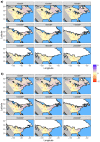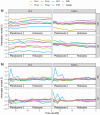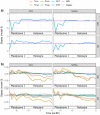Relationships between climate and phylogenetic community structure of fossil pollen assemblages are not constant during the last deglaciation
- PMID: 34237071
- PMCID: PMC8266067
- DOI: 10.1371/journal.pone.0240957
Relationships between climate and phylogenetic community structure of fossil pollen assemblages are not constant during the last deglaciation
Abstract
Disentangling the influence of environmental drivers on community assembly is important to understand how multiple processes influence biodiversity patterns and can inform understanding of ecological responses to climate change. Phylogenetic Community Structure (PCS) is increasingly used in community assembly studies to incorporate evolutionary perspectives and as a proxy for trait (dis)similarity within communities. Studies often assume a stationary relationship between PCS and climate, though few studies have tested this assumption over long time periods with concurrent community data. We estimated two PCS metrics-Nearest Taxon Index (NTI) and Net Relatedness index (NRI)-of fossil pollen assemblages of Angiosperms in eastern North America over the last 21 ka BP at 1 ka intervals. We analyzed spatiotemporal relationships between PCS and seven climate variables, evaluated the potential impact of deglaciation on PCS, and tested for the stability of climate-PCS relationships through time. The broad scale geographic patterns of PCS remained largely stable across time, with overdispersion tending to be most prominent in the central and southern portion of the study area and clustering dominating at the longitudinal extremes. Most importantly, we found that significant relationships between climate variables and PCS (slope) were not constant as climate changed during the last deglaciation and new ice-free regions were colonized. We also found weak, but significant relationships between both PCS metrics (i.e., NTI and NRI) and climate and time-since-deglaciation that also varied through time. Overall, our results suggest that (1) PCS of fossil Angiosperm assemblages during the last 21ka BP have had largely constant spatial patterns, but (2) temporal variability in the relationships between PCS and climate brings into question their usefulness in predictive modeling of community assembly.
Conflict of interest statement
The authors have declared that no competing interests exist.
Figures





References
-
- Jackson ST, Overpeck JT. Responses of plant populations and communities to environmental changes of the late Quaternary. Paleobiology. 2000;26: 194–220.
-
- Shuman B, Newby P, Huang Y, Webb T III. EVIDENCE FOR THE CLOSE CLIMATIC CONTROL OF NEW ENGLAND VEGETATION HISTORY. Ecology. 2004;85: 1297–1310. doi: 10.1890/02-0286 - DOI
-
- Lebrija-Trejos E, Pérez-García EA, Meave JA, Bongers F, Poorter L. Functional traits and environmental filtering drive community assembly in a species-rich tropical system. Ecology. 2010;91: 386–398. Available: https://esajournals.onlinelibrary.wiley.com/doi/abs/10.1890/08-1449.1 - DOI - PubMed
-
- Williams JW, Jackson ST. Novel climates, no-analog communities, and ecological surprises. Front Ecol Environ. 2007;5: 475–482. Available: file://localhost/Users/jessicablois/Documents/Work/Papers/2007/Williams/Frontiers%20in%20Ecology%20and%20the%20Environment%202007%20Williams.pdf papers://3B9B6E65-F46E-438D-9F57-36DC033A5A66/Paper/p17355
MeSH terms
Associated data
LinkOut - more resources
Full Text Sources
Medical

